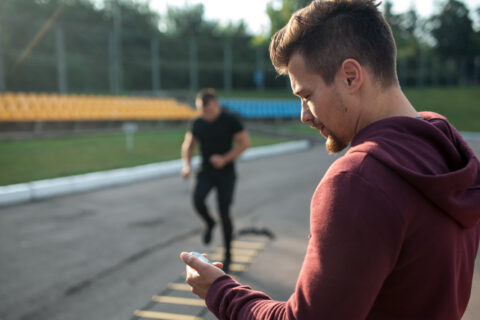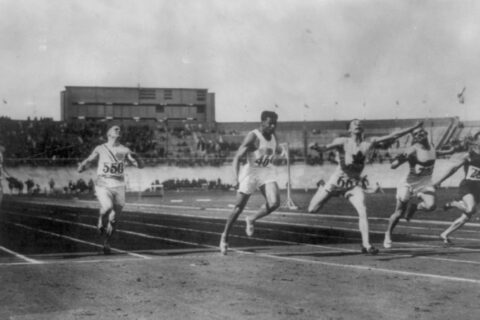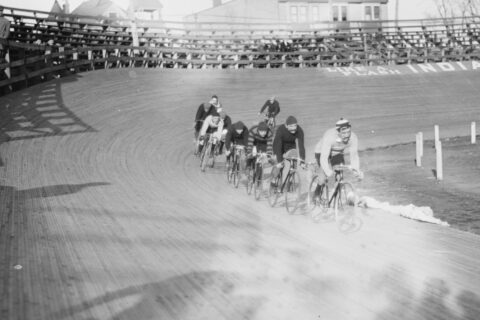We know him as a sports scientist, but he’s also a father and coach. In this eight-part video series, we see Dr. Stephen Seiler in all three roles as he talks candidly with his daughter Siren about her return to training after struggling with an eating disorder and RED-s.
Video Transcript
Dr. Stephen Seiler 00:01
In March 2020, your race weight was probably right around 50 kg, 49-50. Would we say that’s right?
Siren Seiler 00:12
No, not that low. It was probably around 50. But it wasn’t under because I’ve been there as well, and know the difference.
Dr. Stephen Seiler 00:26
Let’s just be honest and say you were underweight in terms of, biologically, you were still amenorrheaic, and you had been for several years.
Siren Seiler 00:38
Six years, about.
Dr. Stephen Seiler 00:41
Based on all that, you were training quite a lot, 120-130K a week, even peaks above that, I think. Racing pretty well, 1:16 half marathon and 34-high 10K. But you weren’t healthy? I mean, you were not fully normalized hormonally. Let’s put it that way, and energetically, you were on a deficit. Is that a reasonable way to put it together?
Recovering from Anorexia
Siren Seiler 01:14
Absolutely. I mean, it is a long story, and we do cover it in the first video we did together. But I was severely anorexic for a few years. In 2018 it was by far the worst. It was a life-threatening situation, and I slowly got better. Running was a part of the solution for me to get into a better place both mentally and physically. But, of course, it comes with a high energy cost. But in 2020, I was definitely healthy, in many ways. But also, I was still just low energy availability, and didn’t have my period, hormones were still low. I was very flat in terms of like mood, and so definitely was not in a very healthy place. All my energy basically went to running, or school, and running as fast as I could and training as much as I could. It was very little, for other things, like just enjoying life in general, even.
Dr. Stephen Seiler 02:35
I’m your Dad, and so I can say this, you were in a bubble—I would say an emotional, intellectual bubble. Everything was pulled into the things that you could control, and running was one of the things that you could control. That’s where you were the last time we were speaking, you did a good job of smiling and hiding it at times. But that’s where you were. Then you moved to Oslo in January 2021. Things kind of start slowly changing for different reasons.
Anyway, a lot of things are getting better, then you go to Oslo and you kind of want to try a bit of a different training approach. You want to get better at more shorter distances, and we have the Jakob or the Ingebrigtsen model is popular as you might expect in Norway. You join a very good club in Oslo, a good club with a lot of female athletes.
One of the things that happened, let’s first talk about the training issue, because now, Dad has been the coach for two to three years or so. I’ve been both coaching you to try to help you become a better runner, but I’ve also been coaching you to try to keep you, well, I don’t want to be melodramatic, but keep you alive, or at least keep you healthy enough that you’re moving forward and not falling backwards again. That was two things in my head at the same time as coach, and then you make some pretty good progress in that last half of 2020, some things start to click in your head. It moves you towards normalization I would say, without going into all the details, but then you moved to Oslo you say “Hey, I’m ready to leave the comfort of home, I’m ready.” You did a bachelor’s degree in English, so now you’re ready to go back into sports science, study sports at the Norwegian Sport University in Oslo. That in itself was kind of a sign that things are getting better because before, that was just too much.
Time for Change
Siren Seiler 05:11
The last part of 2020 I was getting very tired, emotionally and physically. There was this final race where me and my dad went together and it was supposed to be a very fast race, like a very fast course. I basically ended up running a 10K slower than my 10K time in the half marathon. I was just, I was really anxious, and I was just totally out of it. It was a very bad experience for me, and after that race my head just kind of took a shift and realized, okay, there’s something here that I need to fix. One of those things was just, I didn’t want to continue doing my master’s in English. I figured out I actually want to study sports science, which had been my plan since I was very young, like 10 years old, maybe. Overnight, I applied for a student department in Oslo and decided to apply for totally new school and totally new subjects, and change clubs and also wanted to try some shorter distances. It was probably a lot at the same time, I tried to fix some of the things, that wasn’t really the problem. Like, my training wasn’t the problem, it was all the things around nutrition, my social environment, and my own attitude, maybe too.
Dr. Stephen Seiler 07:15
It’s funny you say, because I remember us having coffee, downtown in our hometown, and all of a sudden, you unleashed all this on me, “I have decided I’m leaving Kristiansand, I am dropping the master’s program I am in, and joining something else, I’m changing clubs, and I’ve already started the application process.” I mean, this happened, when your brain made the decision, it was just like bing, bing, bing, bing. I’ve been there. I think in that sense, when you know, you know, and you kind of just had an epiphany, as you say, maybe not every aspect of the epiphany was correct. But it all moved you towards changing, and in the end, most of the process was good, because it took you down the path towards everything normalizing and you being the kid in front of the camera today. That’s just in a different situation. But anyway, so you moved to Oslo. Training wise, you adopted an approach that is attributable to the Ingebrigtsen model, with some pretty standardized workouts on the track.
Siren Seiler 08:41
I was used to doing or training on a nine-day cycle. My focus was volume and getting a lot of low-intensity work, but a couple very high quality sessions, not like Zone 5 all the way, but a lot of minutes in Zone 4. So, two sessions per nine days was like that sort of workout and I had one longer run like about 25K and the rest like around 75 to 80 minutes. A very good or typical polarized intensity distribution.
But then when I changed clubs, I started training like them, more middle distance, at least for them it was. We did three hard sessions per week. One of them being 20 x 400 meters with four to five seconds recovery at around 5K pace, a little bit higher even. One long interval session there was 10 x 4 minutes or 1K. Then on Saturdays, hill repeats session 20 x 200m hill repeats. It was a lot of hard, high speed, high mechanical load sessions, and not what I was used too, like doing long intervals and kind of extending the length at the same pace before I intensified.
Whereas here, it was kind of the opposite, I felt like it was more focused on getting more time at high paces. But, the cardiovascular part wasn’t as emphasized in terms of like, maintaining speed over distance. I didn’t feel like I became better at the 10K by doing 20 x 400m repeats, like, it didn’t give me confidence to hold that speed over a longer distance. But I became very good at that particular session, and my lactate levels dropped each session, which they used to control intensity, very lactate-based, like pricking your finger every fifth interval or so.
Dr. Stephen Seiler 11:20
The argument was, as I recall, that you were keeping it at threshold, that was a term that was used based on lactate. This is an interesting problem, I would say, because the mechanical load was definitely well above threshold pace, you weren’t running ever at threshold pace to be honest in any of those workouts. But it was that you come into this kind of a quasi-steady state with lactate maybe at 4 millimoles or 3.8, or whatever. We say, “Okay, that’s threshold.” Well, it didn’t work out that way because the loading on the legs was huge compared to what were you were used to, I think would be reasonable. It wasn’t just you.
Overtraining and Injury
Siren Seiler 12:07
No, I’m not going to name any names but there was quite a lot of injuries, to put it that way. Like the people I knew, that I was running with, quite a few struggled with injuries like stress fractures. This was the first time I even heard, like, really heard of it, because I ended up getting a stress reaction myself. But yeah, I was kind of surprised to see how many were injured, and I don’t think communities, they don’t really see that maybe there is a problem here with the training. Of course, for some people, it works very well. But for the majority, it doesn’t work very well, so that is maybe why there’s only a very few at the very top.
Dr. Stephen Seiler 13:07
We can, we could talk about progression and years of adaptation versus trying to transition into something too quickly. Even athletes that were used to 10 x 400, the transition to 20 x 400 got them hurt. Just the mechanical load increases were still pretty drastic. That’s a cautionary tale of switching to a popular training methodology that you may not really know enough about or have enough background or basis to do. Not to disparage, I mean, we have, if we if we call this the Ingebrigtsen method, then we can also say well, Jakob Ingebrigtsen is one of the absolute best middle distance runners in the world. He can run a darn elite world class 5K and probably a world class 10K as well. But you can’t really compare him, who’s been training essentially this way since he was 10, with a typical 22-year-old. Anyway so so these are things that you learned, you learned it the hard way, I have to say, because it first went a bit better and then it went way worse.
Learning What Works
Siren Seiler 14:31
Of course, a lot of it had to do with just me as well. I wanted to do what the other people were doing, I wanted to train like the best or I wanted to feel part of like a community and just feel belonging really. Also this was during the pandemic with like a lockdown everywhere. I was able to train together with a group because we were all like qualified by the national organization, or as like top athletes because we were at national level. That gave me a sense of belonging to a community, and just a social aspect that I hadn’t had before in my training, because I used to do most of my training alone. That was a good thing for me to experience.
I realized that that is also individual and some people do like to train together with others for every session, whereas me, I actually like doing my intervals by myself. Also running longer, easy runs by myself. Not always, but it gives me time to think and just relax and I can run my own pace. I find myself training better and more controlled intensity-wise, by doing that, instead of hanging on to a group. That was something I learned as well.



